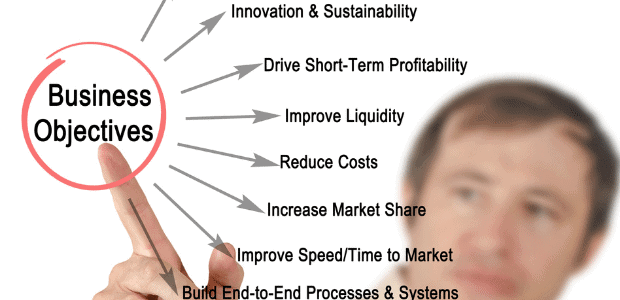Business Metrics Objectives – What You Need to Know
Table of Contents
ToggleTo change something, you must measure it. The duty of management in any organization is to paint a vision, state how you will get there, and continuously measure your progress. Failure to measure progress can lead to poor business outcomes –and this is where business metrics objectives come in handy. The term “metrics” refers to the numerical measurement of something capable of being measured. In business, metrics provide management with actionable insights that ensure they steer the organization towards the vision.
Good companies create well-reasoned vision statements and action plans – but great companies follow through on plan execution and continuously monitor results.
It is impossible to understand the effectiveness of your vision and values – and if your staff is taking them to heart – without an objective way to measure the impact of your strategies and ideas. On the flip side, it is also challenging to know whether an idea is hurting your business without a set of objective metrics.
The sea of technical jargon in the field of business metrics objectives is not for the faint-hearted. Below, we explain business metrics objectives, business goals, and how to develop key performance objectives. Let’s begin by examining a few basic concepts.
What are Business Metrics Objectives, Goals, Strategy, Tactics, and KPIs?
Business metrics objectives are the results that a business wants to achieve within a specified timeframe. Unlike goals, objectives are broad – but both business metrics objectives and goals are quantifiable outcome-based statements.
You may have heard that goals are SMART, which is an acronym for Specific, Measurable, Attainable, Relevant, and Time-bound.
A strategy is how you set out to achieve a goal, while tactics are the specific actions that you will take to execute the strategy and achieve your business metrics objectives.

A key performance indicator, or KPI, is a metric used to determine the effectiveness of tactics performed over time.
Assuming you sell a physical product, below is an example that further helps you understand these concepts:
- Objective: Make a profit.
- Goal: To sell x amount of product within 30 days at y price.
- Strategy: Promote the product on social media.
- Tactics: Run ads on Facebook, YouTube, and Instagram for two weeks.
- KPI objectives to measure: Sales revenue, advertising impressions, engagement rate, website visitors, etc.
Tracking the different business metrics objectives allows you to assess whether your overall strategy is working or needs improvement.
Key Performance Indicators
As mentioned above, KPIs are associated with goals and business metrics objectives – the elements of what you want to achieve within a specified time. KPIs are the quantifiable pieces of your goals and business metrics objectives. To put together great KPIs and make sure they work for you, they need to have the following attributes:
- Measure: This is what you are trying to quantify. You must be as expressive as you possibly can with your measures. For example, rather than merely measuring the number of customers, you can be more expressive and measure the number of new customers this year or the number of new customers for a specific product.
- Target: This is the numeric value that you want to achieve. The measure and target need to work hand in hand in terms of both being either a number, percentage, rate of change, etc.
- Source: Be clear on where you are getting your data – often, businesses have multiple data sources and fragmented systems.
- Frequency: How often will you be reporting on your key performance objectives? Ideally, it would be best if you ran monthly strategy reviews to report on your plan’s progress, in which case you will have monthly KPIs.
Having understood the attributes of KPIs, let’s consider some key performance objectives examples:
- Raw: A raw KPI is simply a numerical value statement – the number of things, items, etc.
- Progress: A progress KPI is expressive and is a common method of measuring a KPI. For example, the percentage of something. It’s a good measure when you don’t have the raw data and want to track the goal’s performance.
- Change: This KPI is also expressive and shows the target’s movement – for example, a percentage increase in sales this period compared to the previous period. The change KPI tells more of a story than the raw data KPI.
It is also essential to understand the difference between leading and lagging indicators. This categorization is best understood by way of an example; a percentage increase in sales is a lagging indicator because it measures an outcome (i.e. something that has already happened), while a sales pipeline is a leading indicator because it is forward-looking and tells you whether you are going to hit your sales targets.
How to Develop Great Business Metrics Objectives
Let’s now consider how to develop useful business metrics objectives for your business using KPIs. Below are 15 elements that go into the development of great key performance indicators.
- Define the strategic goal: Ensure that all business metrics objectives are linked to a strategic goal – indicators exist to track how well you are delivering on your strategy. For example, if you are interested in financial performance, your strategic goal could be to grow your profit margin.
- Be clear about the audience: Every indicator must have an audience. The clearer you are about the consumers of this information, the better your indicators will become. For example, for marketing performance, the primary audience could be the Board. You can have secondary audiences, such as the marketing team.
- What questions are the business metrics answering?: You can call these the key performance questions. For example, to what extent are you delivering bottom-line results? These questions are open and forward-looking and trigger discussions when people read them.
- How will the indicator be used?: You need to understand how the indicator will and will not be used. For example, you may need to state whether the indicator is being used to evaluate individual or team performance.
- Name the indicator: Give your indicator an appropriate name. For example, if you measure profits, there are many profitability metrics such as gross profit margin, net margin, operating profit, etc.
- Data collection methodology: Consider where you will source data for your business metric. For example, for financial business metrics, you can extract the data from the accounting system. For human resource metrics, the data may come from a staff survey or customer feedback.
- How will it be measured?: Be clear on how the business metric will be calculated. Define the assessment criteria, formula, or scale that you will use. There are many ways to do this, but the point is to be clear on how you arrive at a measure.
- Performance threshold: Every target needs a performance threshold. Define what success looks like – indicators are not targets, and many managers make this mistake. What you need are benchmarks for continuous reference.
- How often is the data collected?: Organizations tend not to collect data frequently enough. For example, many businesses rarely conduct internal or external surveys.
- Reporting frequency: Be clear about when the data will be reported. You may need to have dashboards in place or periodic review management to align your data collection and reporting.
- Responsible person: An individual in the team needs to be put in charge of making sure the data is being collected, analyzed, and used.
- Expiry date or revision date: Organizations tend to add new indicators every so often, such as when there is a change in senior management. When this happens, it can lead to a bloated performance management system. But when you have an expiry date or revision date, it forces you to re-examine your business metrics objectives and KPIs and determine if they are still valid or relevant.
- The cost: Examine the total cost of collecting and analyzing the data needed for a business metric and determine if the benefits justify the cost. For example, financial metrics are often compulsory due to Board and regulatory reporting requirements. However, activities such as customer surveys can be expensive and time-consuming.
- Is the indicator complete?: A KPI may indicate performance but fail to measure it holistically. For example, merely looking at a company’s net profit will never give you a complete picture of its financial health or profitability. A company can sell off old assets and report a substantial net profit at the end of the year. In this scenario, the only way to tell if the company performed well would be to look at its sales revenue in relation to its net profit before the sale of assets.
- Unintended consequences: Finally, you must consider whether there are unforeseen outcomes of your business metrics objectives. Consider the undesired behaviors that your indicator may drive. For example, suppose your focus is on improving profitability and net profits. In that case, it’s elementary for a new CEO to come in, cut operating costs, and immediately have a positive impact on net profits. However, cutting operating costs may have the unintended consequence of stifling sales and marketing in the long-term and negatively impacting revenue. It’s impossible to design a cheat-proof measurement system, but thinking about it helps you control unintended outcomes.
Summary:
Business Metrics Objectives
Let’s now consider how to develop useful business metrics objectives for your business using KPIs. Below are 15 elements that go into the development of great key performance indicators. Define the strategic goal: Ensure that all business metrics objectives are linked to a strategic goal – indicators exist to track how well you are delivering on your strategy. For example, if you are interested in financial performance, your strategic goal could be to grow your profit margin. Be clear about the audience: Every indicator must have an audience. The clearer you are about the consumers of this information, the better your indicators will become. For example, for marketing performance, the primary audience could be the Board. You can have secondary audiences, such as the marketing team. What questions are the business metrics answering?: You can call these the key performance questions. For example, to what extent are you delivering bottom-line results? These questions are open and forward-looking and trigger discussions when people read them. How will the indicator be used?: You need to understand how the indicator will and will not be used. For example, you may need to state whether the indicator is being used to evaluate individual or team performance. Name the indicator: Give your indicator an appropriate name. For example, if you measure profits, there are many profitability metrics such as gross profit margin, net margin, operating profit, etc. Data collection methodology: Consider where you will source data for your business metric. For example, for financial business metrics, you can extract the data from the accounting system. For human resource metrics, the data may come from a staff survey or customer feedback. How will it be measured?: Be clear on how the business metric will be calculated. Define the assessment criteria, formula, or scale that you will use. There are many ways to do this, but the point is to be clear on how you arrive at a measure. Performance threshold: Every target needs a performance threshold. Define what success looks like – indicators are not targets, and many managers make this mistake. What you need are benchmarks for continuous reference. How often is the data collected?: Organizations tend not to collect data frequently enough. For example, many businesses rarely conduct internal or external surveys. Reporting frequency: Be clear about when the data will be reported. You may need to have dashboards in place or periodic review management to align your data collection and reporting. Responsible person: An individual in the team needs to be put in charge of making sure the data is being collected, analyzed, and used. Expiry date or revision date: Organizations tend to add new indicators every so often, such as when there is a change in senior management. When this happens, it can lead to a bloated performance management system. But when you have an expiry date or revision date, it forces you to re-examine your business metrics objectives and KPIs and determine if they are still valid or relevant. The cost: Examine the total cost of collecting and analyzing the data needed for a business metric and determine if the benefits justify the cost. For example, financial metrics are often compulsory due to Board and regulatory reporting requirements. However, activities such as customer surveys can be expensive and time-consuming. Is the indicator complete?: A KPI may indicate performance but fail to measure it holistically. For example, merely looking at a company’s net profit will never give you a complete picture of its financial health or profitability. A company can sell off old assets and report a substantial net profit at the end of the year. In this scenario, the only way to tell if the company performed well would be to look at its sales revenue in relation to its net profit before the sale of assets. Unintended consequences: Finally, you must consider whether there are unforeseen outcomes of your business metrics objectives. Consider the undesired behaviors that your indicator may drive. For example, suppose your focus is on improving profitability and net profits. In that case, it’s elementary for a new CEO to come in, cut operating costs, and immediately have a positive impact on net profits. However, cutting operating costs may have the unintended consequence of stifling sales and marketing in the long-term and negatively impacting revenue. It’s impossible to design a cheat-proof measurement system, but thinking about it helps you control unintended outcomes.





